XGSLab™ Grounding Solution
EasyPower is partnering with the industry-leading grounding and EMI analysis expert company, SINT Srl (website), which offers a software package to analyze and design grounding, lightning and electromagnetic interference problems by focusing on its powerful and yet affordable grounding analysis software packages, XGSLab. Bentley Systems-EasyPower is the exclusive representative of XGSLab software in the USA and Canada.
Learn More About XGSLab Today
You can also contact us if you have questions, to get a quote, or would like to schedule a one-on-one session with an application engineer.
XGSLab
XGSLab is one of the most powerful software for electromagnetic simulation for power, grounding and lightning protection systems and the only software on the market that takes into account International (IEC/TS 60479-1:2005), European (EN 50522:2010) and American (IEEE Std 80-2000 and IEEE Std 80-2013) Standards in grounding system analysis.
Learn More About Grounding
New - XGSLab and Grounding Analysis Course (Paid). This self-pace online class covers grounding system components, permissible voltage limits per IEEE Std 80, soil model development, fault current split, and more grounding analysis concepts to provide personnel and public safety at power systems. This course shows how to use the XGSLab® software to design and evaluate your grounding systems. The course offers 0.2 CEU credits (issued by IEEE). Info and registration
Electrical Grounding Resource Center. EasyPower offers one of the best resources in the industry for learning about grounding and related topics. It contains many articles and videos, from basic to advanced, with new content being added on a regular basis. Visit now: Grounding Resource Center
Quarterly Grounding Workshop. EasyPower is pleased to offer a new quarterly grounding workshop. This free two-hour workshop is given by David Lewis, an electrical engineer at EasyPower, and it provides an interactive demonstration for evaluating grounding systems to improve engineering tools and knowledge. Sign up for the next workshop here:
2025
- Wednesday, February 19, 2025. 8:00am to 10:00am - Pacific Time - Completed
- Wednesday, May 21, 2025. 8:00am to 10:00am - Pacific Time - Completed
- Wednesday, August 27, 2025. 8:00am to 10:00am - Pacific Time - Register Now
New XGSLab 10.3 Product Update
The engineers at SINT Srl in Italy have recently released version 10.3 of XGSLab, with multiple additions and enhancements, including Lorentz Forces for EM short circuit forces, automated surge protective devices, graphical energizations and, and more.
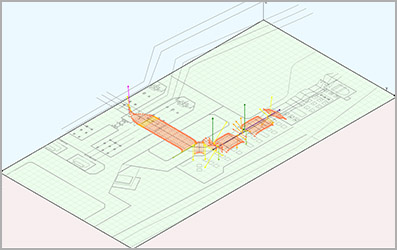
- Electromagnetic forces and effects
- Surge protective device for XGSA_FD
- Graphical elements entry
- Inject currents
- External electromotive forces
- Longitudinal and transverse impedances
- Continuity for infinite conductors
- Reference points
- Scheduler “on-tag” parameter
- Constrained soil curve
- Minor bug fixes
Watch this video showing some of the updated features in the XGSLab 10.3 release.
Read the full list of updates and enhancements.
Why XGSLab
- EASY: A program with an intuitive interface. Very easy even for beginners. Users expert with competitors tools can directly use XGS.
- WORLDWIDE: The only software in the market that takes into account International (IEC), European (EN) and USA (IEEE) standards.
- VALIDATED: Accuracy validated since 1990 by comparison with analytical cases, published research, field measures, and similar programs.
- COMPLETE: A complete tool for the simulation of Power, Grounding and Lightning Systems.
- ADVANCED: Based on full-wave PEEC model and then suitable for general applications, in a wide frequency range, with arbitrary conductors arrangements and many soil models including multilayer.
- OPEN: Frequency dependent self and mutual impedances can be exported to EMTP® to study the dynamic behavior of grounding systems. Layout data can be imported / exported from / to AutoCAD®. Numerical output can be read by MATLAB® or EXCEL®.
- POWERFUL: A powerful code that uses parallel computing.
XGSLab Module Options
- GSA (Grounding System Analysis) for many practical low frequency underground system evaluations, including multi-energized models and conductive coupling. Details
- GSA_FD (Grounding System Analysis in the Frequency Domain) for evaluating large underground systems, incorporating self and mutual impedances, and capable of analyzing multi-energized systems. Details
- XGSA_FD (Above and Below Ground System Analysis in the Frequency Domain) for analyzing electromagnetic fields and interference for overhead and below-ground systems, evaluation of lightning effects, three dimensional fault current distribution, and power system simulations. Details
- XGSA_TD (Above and Below Ground System Analysis in the Time Domain) for analysis in the time domain to calculate current and potential distribution on underground and overhead conductor networks, the resulting earth surface potentials, and electric and magnetic fields energized by current or voltage transients. Details
- SHIELD (Lightning Shielding) for the evaluation of lightning protection systems and structures for direct lightning strokes using the Rolling Sphere method or Eriksson Method in a full 3D graphical application. Details
- NETS (Network Solver) for detailed evaluation of multi-conductor, multi-phase, multi-ground power networks including the neutral conductors and earth path during steady state or fault conditions. Details
The GSA, GSA_FD, XGSA_FD, and XGSA_TD modules are perfectly suited for many engineering appli¬cations, as these modules are based on the PEEC (Partial Element Equivalent Circuit) Method, which is a powerful and flexible numerical method. Similarly, the NETS module is based on the phase compo-nents method and graphs theory, overcoming limitations with the sequence components method.
All modules are integrated in an “all-in-one” package and provide professional development to im¬plement efficient computation speeds. XGSLab is easy to use and well suited for complex scenarios making it a virtual laboratory.
Hybrid methods combine the strengths of other methods and are well suited for engineering purposes because they allow the analysis of complex scenarios including external parameters such as voltages, currents and impedances. For these reasons, XGSLab can be considered a real laboratory.
Videos - See a full set of Product Feature Videos
Applications
The following table summarizes the main applications of the available models.
| Application | GSA | GSA_FD | XGSA_FD | XGSA_TD | NETS | SHIELD |
|---|---|---|---|---|---|---|
| Grounding (equipotential systems) | Yes | Yes | Yes | Yes | ||
| Grounding (general systems) | Yes | Yes | Yes | |||
| Cathodic Protection Systems | Yes | Yes | Yes | |||
| Magnetic Field | Yes | Yes | Yes | |||
| Electric Field | Yes | Yes | ||||
| Electromagnetic Interferences | Yes | Yes | Yes | Yes | ||
| Corona Effects | Yes | |||||
| Switching Transients, Lightning and Fault Transients in GIS | Yes | |||||
| Steady State Solver for Full Meshed Multi-conductor and Multi-phase Networks | Yes | |||||
| Short Circuit Current on Full Meshed Multi-conductor and Multi-phase Networks | Yes | |||||
| Fault Current Distribution on Full Meshed Multi-conductor and Multi-phase Networks | Yes | |||||
| Lightning Shielding | Yes |
Product Details
GSA (Grounding System Analysis)
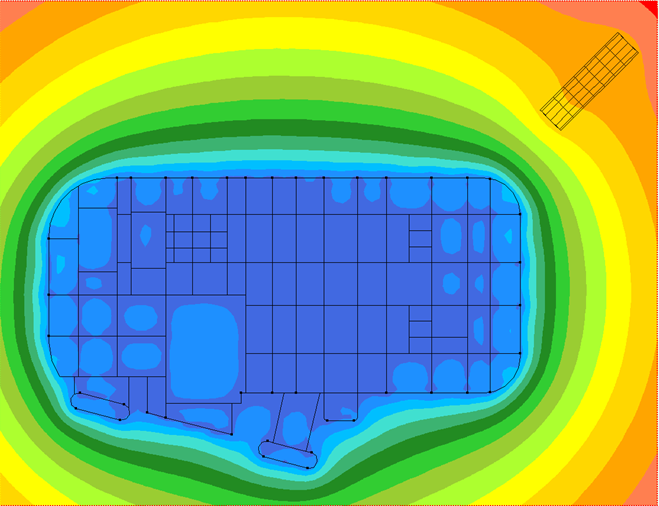 GSA is a widely utilized and recognized module for earth grid calculations and design including soil analysis.
GSA is a widely utilized and recognized module for earth grid calculations and design including soil analysis.
- GSA is based on a PEEC static numerical model and to the equipotential condition of the electrodes and can analyse the low frequency performance of grounding systems composed by many distinct electrodes of any shape but with a limited size into a uniform or multilayer soil model.
XGSLab GSA Tutorial Video - A Grounding System Analysis Applying the EN 50522 Standard
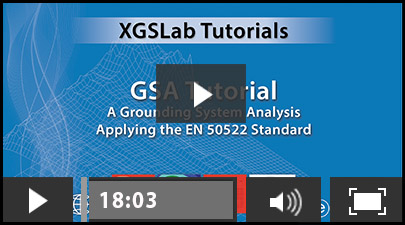
This video follows the XGSLab tutorial documentation for the GSA module incorporating the EN 50522 standard. In the tutorial, a substation grounding system is subjected to a fault resulting in a ground/earth potential rise at the grounding system. We also model an adjacent tank buried in the earth that is a recipient of voltages transferred through the soil. In the video we use the Soil Resistivity Analyzer to determine a soil model from Wenner resistivity measurements, then proceed to import our grounding systems for the substation and the buried tank from an existing DXF. The fault current split tool is used to calculate the fault split, reducing the total fault contributing to the ground/earth potential rise. Safety plots are generated based on the permissible touch and step voltage limits with regard to EN 50522 standard.
GSA_FD (Grounding System Analysis in the Frequency Domain)
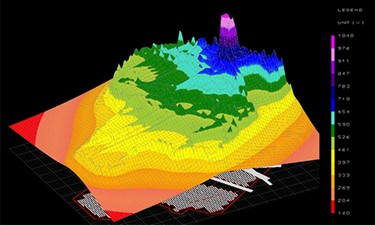 GSA_FD is a module for earth grid calculation and design in the frequency domain, including soil resistivity analysis and represents the state of the art of grounding software.
GSA_FD is a module for earth grid calculation and design in the frequency domain, including soil resistivity analysis and represents the state of the art of grounding software.
- GSA_FD is based on a PEEC full wave numerical model and can be applied in general conditions with systems composed by many distinct electrodes of any shape, size and kind of conductor (solid, hollow or stranded and coated or bare) into a uniform, multilayer or multizone soil model in a large frequency range from DC to about 100 MHz. It is moreover important to consider that GSA_FD is able to takes into account the frequency dependence of soil parameters according to many models models and in particular in the model with a general consensus indicates in the CIGRE TB 781 2019.
- GSA_FD allows the analysis of large electrodes whose size is greater than the wavelength of the electromagnetic field as better specified in the following. GSA_FD then overcomes all limits related to the equipotential condition of the electrodes on which GSA is based. With the equipotential condition hypothesis, the maximum touch voltage is widely under estimated and this may result in grounding system oversizing with additional cost sink even 50%.
- The implemented model considers both self and mutual impedances. Experience shows that often, mutual impedances cannot be neglected not even at power frequency. A few competitors take into account self impedance and a very few competitors consider the mutual impedance effects and this can lead to significant errors in calculations. Neglecting self impedance effects is often unacceptable, but neglecting mutual impedances can lead to errors over the 20% in calculations also at power frequency. It is important to consider that calculation accuracy often means saving money and indeed, so GSA_FD can allow a significant cost saving in grounding system construction and materials.
- GSA_FD can also calculates magnetic fields due to grounding systems or cable, and electromagnetic interferences (induced current and potential due to resistive, capacitive and inductive coupling) between grounding systems or cable and pipeline or buried electrodes in general.
- In DC conditions, GSA_FD is a good tool for cathodic protection and anode bed analysis with impressed current systems.
XGSLab GSA_FD Tutorial Video - A Grounding System Analysis Applying IEEE Std 80
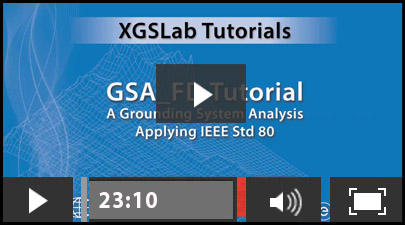
This video follows the XGSLab tutorial documentation for the GSA_FD module incorporating the IEEE Std 80-2013. In the tutorial, a substation grounding system is subjected to a fault and transfers the ground/earth potential rise to the connected steel factory grounding system. In the video we use the Soil Resistivity Analyzer to determine a soil model from Wenner resistivity measurements, then proceed to import our grounding systems for the substation, steel factory, and adjacent site entrance from an existing DXF. The fault current split tool is used to quickly determine fault split calculation, reducing the total fault contributing to the ground/earth potential rise.
XGSA_FD (Above and Below Ground System Analysis in the Frequency Domain)
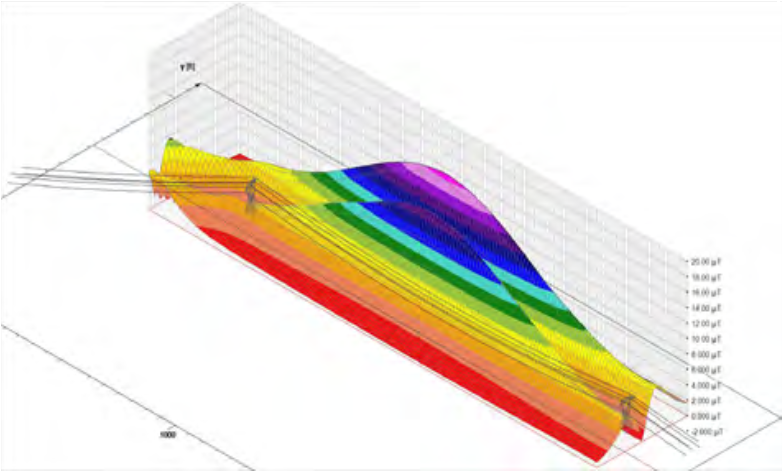 XGSA_FD extends the GSA_FD application field to the overhead systems.
XGSA_FD extends the GSA_FD application field to the overhead systems.
- Also XGSA_FD is based on a PEEC full wave numerical model and can be applied in general conditions in the same frequency range of GSA_FD.
- XGSA_FD can also manage catenary conductors and bundle conductors too and can take into account sources where potential or leakage current and longitudinal current are forced and independent by other conditions. For these reasons XGSA_FD is probably one of the most powerful and multipurpose tool on the market for these kind of calculations.
- In addition to GSA_FD, XGSA_FD can calculate electromagnetic fields and interferences between above and below ground systems (for instance between overhead or underground power lines and installation as pipelines, railways or communications lines).
- XGSA_FD integrates a powerful tool for the evaluation of the corona effects (power losses and radiofrequency interferences).
XGSLab XGSA_FD Tutorial Video
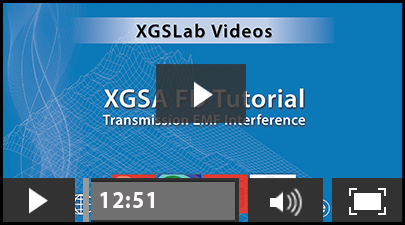
This video follows the XGSLab tutorial documentation for the XGSA_FD module. In this tutorial, a transmission line’s electromagnetic field (emf) interferes is computed with an adjacent buried pipeline. In this shared corridor or AC Interference study, we import the transmission line and pipeline into XGSLab using an existing DXF model. XGSLab calculates the induced voltage on the pipeline from the steady state operation of the transmission line. The transmission line’s effects on the pipeline during a fault are evaluated by slight modifications to the model rather than importing a new DXF from XGSLab’s helpdesk as instructed by the step-by-step tutorial documentation.
XGSA_TD (Above and Below Ground System Analysis in the Time Domain)
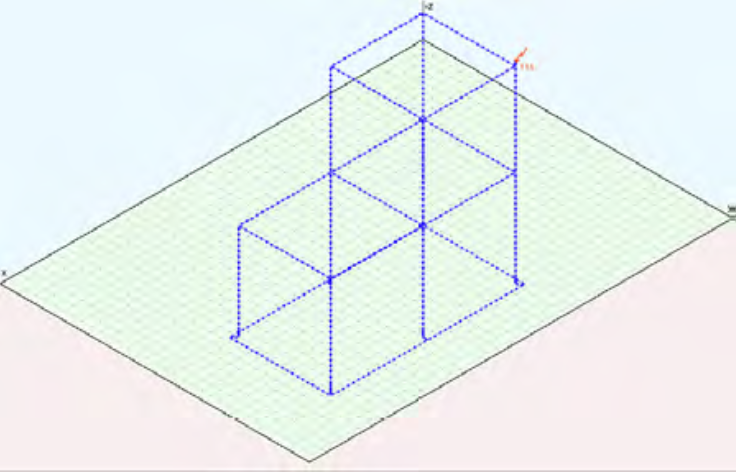 XGSA_TD is a powerful module which extends the XGSA_FD application field to the time domain.
XGSA_TD is a powerful module which extends the XGSA_FD application field to the time domain.
- In this regard, XGSA_FD uses the so called “frequency domain approach”. This approach is rigorous and allows considering the frequency dependence of soil parameters.
As known, a transient can be considered as the superposition of many single frequency waveform calculated with the forward Fast Fourier Transforms (FFT). - Using the frequency domain PEEC model implemented in XGSA_FD it is then possible calculate a response for each of these single frequency waveform.
- The resulting time domain response can be obtained by applying the Inverse Fast Fourier Transform to all these responses calculated in the frequency domain.
- The calculation sequence implemented in XGSA_TD is also called FFT – PEEC – IFFT.
- XGSA_TD has been tested for the simulation of transients with a maximum frequency spectrum up to 100 MHz and then can be used for switching transients, lightning and also in fault transients in GIS.
- XGSA_TD includes an option to export frequency dependent self and mutual impedances to EMTP® or ATP® in order to simulate with a rigorous model the dynamic behaviour of large grounding systems during electromagnetic transients.
SHIELD (Lightning Shielding)
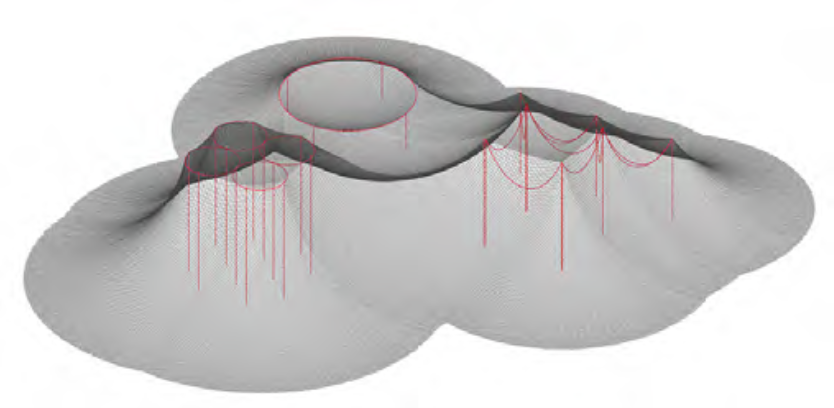 SHIELD for the evaluation of lightning protection systems and structures for direct lightning strokes using the Rolling Sphere method or Eriksson Method in a full 3D graphical application.
SHIELD for the evaluation of lightning protection systems and structures for direct lightning strokes using the Rolling Sphere method or Eriksson Method in a full 3D graphical application.
- Calculation method based on Rolling Sphere and Eriksson methods
- Rolling Sphere method implemented using numerical model suitable for structures up to 60 m high
- Apply International (IEC 62305-3:2012), European (EN 62305-3:2012), and American (IEEE Std 998-2012) standards
- Analysis of lightning protection systems of any shape (masts, horizontal wires, catenary wires, etc.)
- Surge impedance calculation (according to IEEE Std 998-2012)
- Import geometric layout from DXF files (2D or 3D segments)
- Export layout data and results in DXF file format
- Create layout using OpenGL vector graphics (CAD)
- Represent results using OpenGL vector graphics (viewer)
NETS (Network Solver)
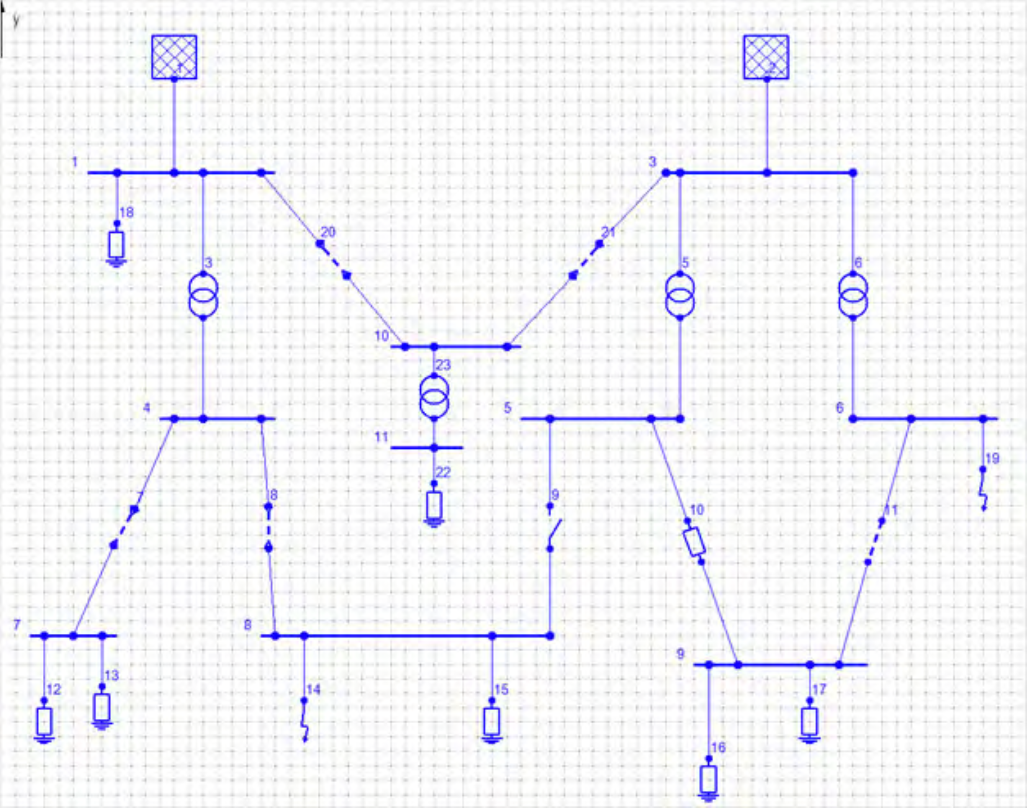 NETS is a very flexible tool able to solve full meshed multi-conductor and multi-phase networks taking into account all the neutral conductors paths as well as the earth path.
NETS is a very flexible tool able to solve full meshed multi-conductor and multi-phase networks taking into account all the neutral conductors paths as well as the earth path.
- NETS is based on Kirchhoff laws for multi-conductor and multi-phase systems.
- This approach is general and overcomes the limits of the classic symmetrical components method and can be used to represent power systems as multi-conductor networks enabling the consideration of asymmetrical and/or unbalanced systems also in presence of grounding circuits or circuits with a different phases number.
- The network components (generators, lines, cables, transformers, loads, switches, faults …) are represented using multi-port cells and the connection between cells is obtained by means of multi-port buses.
- The grounding systems (substation grids, tower footings …) can be specified in an arbitrary way.
- NETS calculates lines, cables and transformers parameters starting on data usually available in commercial data sheet.
- Like the other XGS modules, also NETS has been thought for a use as general as possible.
- NETS can be used to solve transmission and distribution networks in steady state or fault conditions and to calculate potentials and currents or any kind of short circuit currents with or without fault impedances.
- In particular, NETS can be used for the calculation of the fault current distribution in power networks and between power circuits and earth. An accurate knowledge of the fault current distribution is crucial in grounding, mitigation to reduce interference on communication circuits and pipelines, power systems protections calibration and coordination, neutral grounding resistor sizing and many other applications.
- NETS is also useful to calculate data input for other XGS modules (for instance the split factor and the current to earth) without unrealistic assumptions as for instance, magnitude of fault current known and unaffected by grounding impedances, impedances of overhead earth wires or tower footing resistances uniform along the line, or again, infinite length of lines …
- Moreover, NETS represents the link between XGS and the most diffused commercial software for power systems analysis.
Learn More about XGSLab Grounding
- XGSLab Grounding Analysis Assumptions
- XGSLab Grounding Background
- XGSLab Grounding Product Feature Videos
- XGSLab Product Release History
Learn More About XGSLab Today
You can also contact us if you have questions, to get a quote, or would like to schedule a one-on-one session with an application engineer.